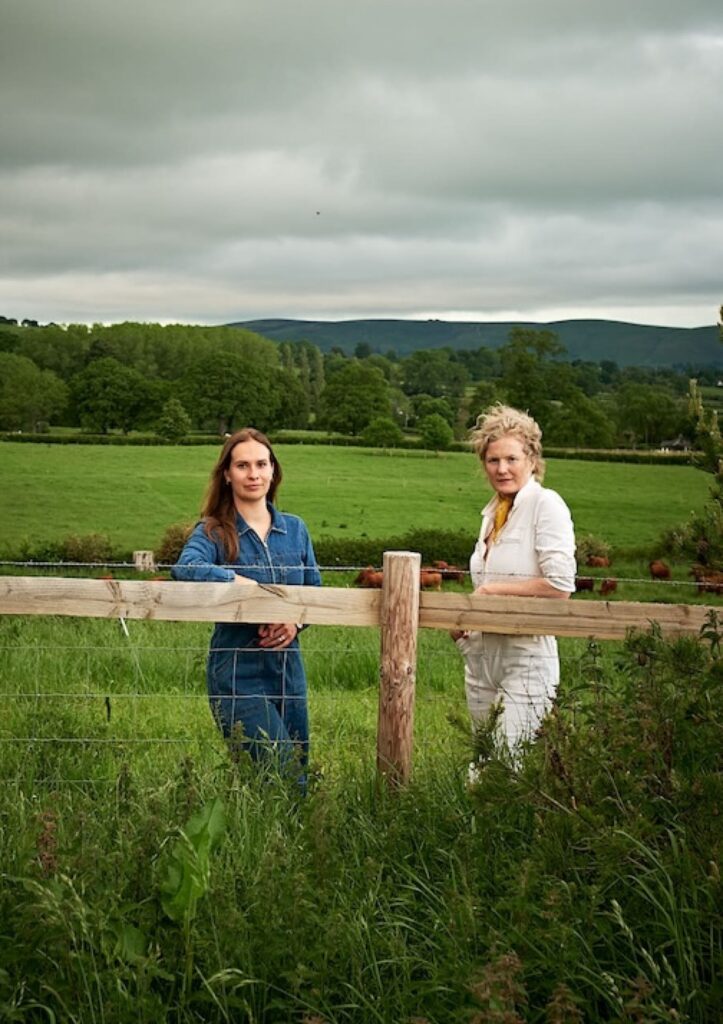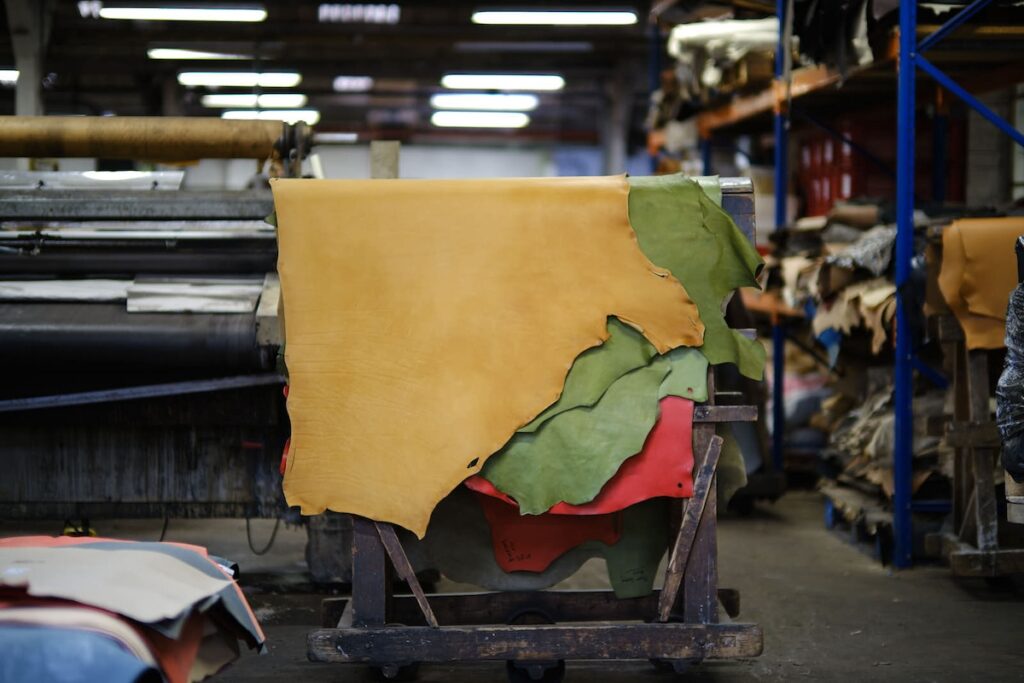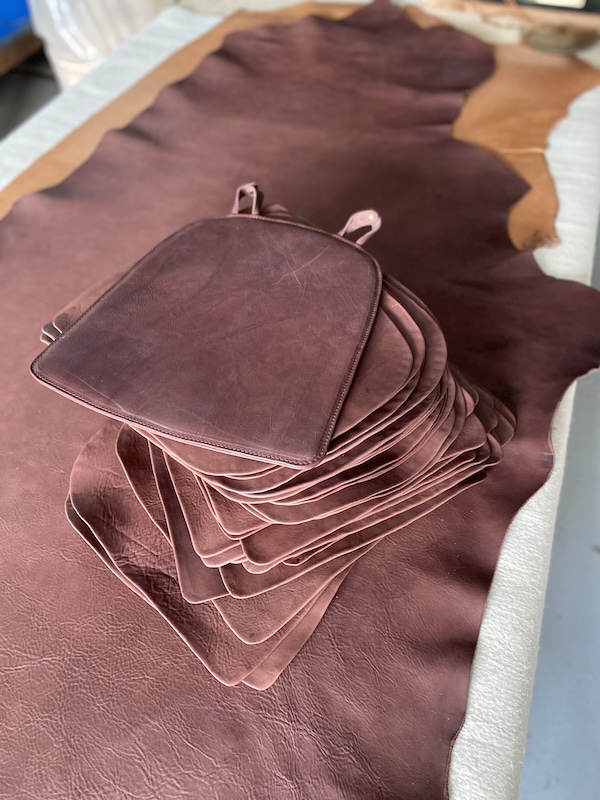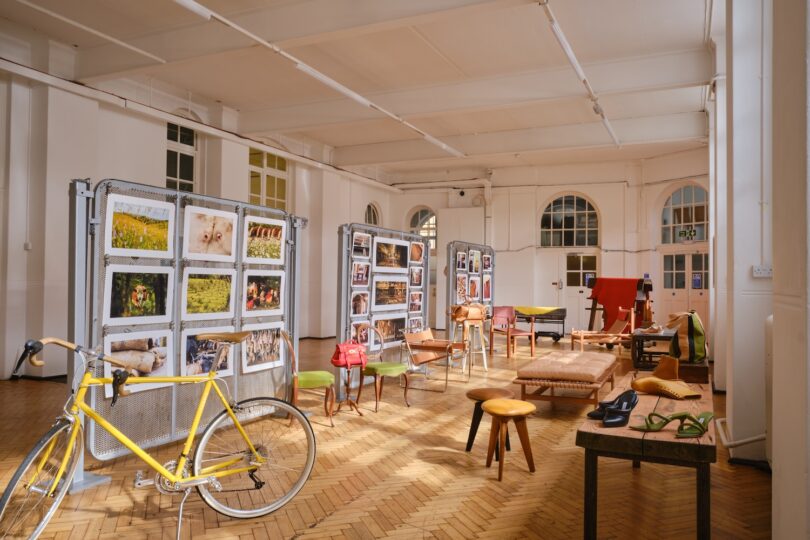Connecting furniture and fashion with regenerative farming, British Pasture Leather is showing that you can be green and very stylish. This imaginative company creates leather with cattle hides from regenerative farms that support ecosystems through environmentally sensitive agriculture with the highest standards of animal welfare.
Sara Grady and Alice Robinson, founders of the company, are redefining how we see leather. These ethical entrepreneurs work closely with farms that produce food sustainably while contributing to rural life and communities. By tracing leather from farm through to the final user, they give people a more ethical choice in the same way we can opt for organic or free-range meat and dairy products.
Not only do Alice and Sara intend to show how sustainability can support farming, but they are trying to transform leatherworking, especially for fashion and furniture. Consumers drive change and British Pasture Leather is meeting the growing demands for ethically-sourced animal products that have a minimal impact on the environment while maintaining the highest quality.

Right: Alice Robinson Left: Sara Grady
We were fortunate enough to talk to Alice and Sara and learned more about their vision for sustainability.
Could you give us some background about yourselves?
Alice Robinson: As long as I can remember. I’ve wanted to make things. I trained as a Pattern Cutter and then went to Edinburgh University to study Womenswear.
My final studies took place at the Royal College of Art where my focus was accessory design. Leather became an exciting material for me to work with because of its reputation as a durable and luxurious material, but also because of all of the stories it could hold within it.
My late father was a farm vet so being amongst a farming community was a large part of our lives. When I looked at leather, I really wanted to understand the material better. What animal has this come from? Why are these marks there on the surface and what systems or practices were behind its creation? I started looking at leather from a point of enquiry and wanted to explore this further and examine the existing narratives.

I bought a sheep from a local farmer and decided to create a collection by working with wool and leather from that sheep. By this point I had graduated. I followed on to create a collection called Bullock 374. This work involved spending a year learning from a local nature friendly farmer and gaining insight on the many stories that are hidden within leather goods.
The collection was subsequently shown at the V&A museum’s exhibit FOOD: Bigger than the Plate and I have since written about that journey in my new book Field, Fork, Fashion: Bullock 374 and a designer’s journey to find a future for leather
At this point I was introduced to Sara Grady, my British Pasture co-founder. From the farming community side and the design side – we were both looking at the hidden provenance of leather.
Sara Grady: I’ve always been involved in creative work and interested in the stories behind things, which initially led me to work as a producer of documentary style and educational media. But at a certain point, I realised that I needed to feel more agency in responding to societal and planetary crises. I identified food as the sector where all my interests and concerns overlap.
I became part of an organisation with a working farm (Glynwood in New York’s Hudson Valley) that practises regenerative agriculture, and for several years I was the VP of Programs, working with farmers and food professionals.
That experience gave me a whole new understanding of animal agriculture: I began to learn it is possible to raise animals in a way that honours their welfare. I saw first-hand how such farms dedicate enormous care and resources to raising animals ecologically and humanely; and I also learned how well-managed grazing can greatly benefit soil and ecosystems, while producing healthy food for people. We were able to honour all of that with a “nose to tail” ethos of valuing and using the whole animal.
But when it came to the hides, I noticed a disconnection. It struck me that the hide, once made into leather, is the part of the animal that endures for a very long time, and it can be a material that speaks to the life of the animal – so I felt we should have the option to choose leather with origins in exemplary farming practices.
When I moved to Europe, a chef friend of mine, who knew of my interest in leather, met Alice and suggested I should talk to her. Alice was coming at the same questions from a designers’ perspective. We had very complementary approaches that eventually led to the idea of collaborating to produce leather that is fully traceable to regenerative farms.
What gave you the idea to set up British Pasture Leather? What inspired you to bring sustainable farming and fashion design together?
We want to support a movement towards regenerative and circular practices, thereby healing our planet and solving environmental crises. We choose to focus on leather production as an overlooked area of opportunity.
We believe regenerative agricultural practices are a crucial solution in renewing soils, stewarding land and reforming food and fashion systems.
Leather is inherently connected to farming, because it is a product of our food system (the majority of leather in the world is bovine, all of which comes from beef production). However, it isn’t often recognised as such. By associating leather with agriculture, we can create choice, so that designers and consumers have knowledge of which food / farming systems the material has emerged from – and we hope, choose to support positive practices.
British Pasture Leather was founded in 2020 as the first supplier of leather that is traceable to regenerative farms in the UK. By linking leather with exemplary agriculture, British Pasture Leather is forging new connections between farming, food, craft, fashion and material culture.
When did you first notice interest from designers and from consumers for ethically-sourced leather? Have you seen demand for such products rise in recent years?
We have been in talks with fashion and furniture designers since our inception. Over time, we developed a really good understanding of our customers, what they’re looking for and in turn what their own customers are asking for.
We know there is a gradual but distinct desire for materials to be less harmful to our world. As more public information becomes visible about the negative environmental impact of fast fashion or industrial scale farming – leather buyers are asking questions and seeking alternative solutions.
We want British Pasture Leather to be a fundamental part of a new sustainable solution in sourcing leather.
Leather is often criticised, and much of the time justifiably so, because global production systems are so closely connected with industrialised animal agriculture which is inhumane and environmentally damaging. But what if we could associate leather with positive systems that honour the lives of farm animals, farmers, and benefit land and ecosystems? That is what regenerative agriculture can do! British Pasture Leather exists to offer a choice of material that has these positive impacts.

How do you find ethical farms and tanneries and ensure that they uphold your values and requirements?
We identify our source farms through our partnership with Pasture for Life, a farmer-led organisation that “champions the restorative power of grazing” by certifying farms that graze cattle on 100% pasture.
With respect to leather production, we focus on producing entirely in Britain, so that we are creating a short, local supply chain. For tanning, we have chosen to use a traditional method called vegetable tanning which uses natural tannins from barks and leaves, and similarly we avoid plastics in the finishing process (most leather, globally, is tanned with metals and chemicals, and coated with polyurethane).
We make these choices to ensure that British Pasture Leather can biodegrade without ecotoxicity at the end of its usable life.
The leather making industry has been vanishing in the UK, sadly, so we have only a few options for production partners in the UK – but thankfully a few remain, and we are very fortunate to work with them!
You ensure that all the leather you produce is traceable. How does that work?
Our traceability system is a product of our strong relationships with everyone along our supply chain: from farm to abattoir to hide yard to tannery to finishing. By working closely with each of those businesses, we have created systems that allow for our hides / leather to retain traceability throughout the entire process.
What are the main environmental benefits of leather from regenerative sources?
Sourcing hides exclusively from regenerative farms has a multitude of environmental benefits. Rotational grazing can promote the sequestration of carbon dioxide from the atmosphere into the soil. Healthier soil contains higher levels of organic matter, which helps in carbon storage, mitigating climate change.
Regenerative farming methods also improve soil health by minimising the use of synthetic fertilisers, reducing water waste and prioritising biodiversity by fostering diverse ecosystems. By preserving natural habitats, these farms support a variety of plant and animal species, contributing to overall ecosystem health.
We also know regenerative farming prioritises animal welfare, allowing cattle to graze in their natural habitats, minimising stress. This can lead to healthier livestock and reduce the need for intensive confinement operations associated with conventional leather production.
In the long term, regenerative farming focuses on building resilience and maintaining the productivity of agricultural land over the long term. By promoting practices that regenerate soil health and ecosystem function, regenerative leather production offers a more sustainable alternative to conventional methods.
What obstacles and resistance have you faced from the farming sector and the world of fashion?
We have been entirely welcomed by the farming and fashion communities. The challenges for us have more to do with the fact that we are creating an entirely new system and story for leather.
Too often, leather is regarded as a cheap commodity that emerges from an anonymous global supply chain. British Pasture Leather, on the other hand, comes from a transparent local supply chain.
Making the links between our production and leather goods brands requires a shift in how the material is perceived and valued. And that process of change can be slower than we would like!
What advice would you give to someone else wanting to follow this ethical path?
Go for it! Whether you are a designer or a farmer or part of the supply chain, we all have a responsibility for the health of our planet. Being transparent and sustainable in the materials we produce, source and select, will help us all minimise the devastating impact of climate change.
Also, driving systemic change is exciting – there’s so much to learn, and so many keen collaborators to work with. It’s very satisfying to be engaged in creative problem solving, to enact new systems that allow us all to be better informed and more accountable for our consumer choices.
What are your hopes for the future of British Pasture Leather?
We want our vision to set a global example and to set a pace for change that others can follow—or join us in our mission!







